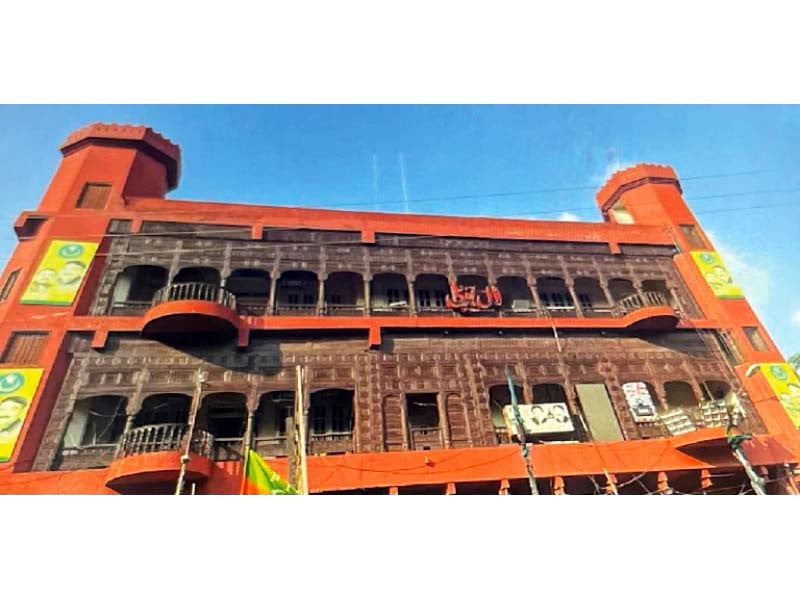Located across from the women’s shopping center, Moti Bazar, in the 200-year-old commercial center of Bohar Bazar, lies Lal Haveli, the center of political activity in the garrison city since 1985.
It was formerly known as Sehgal Haveli and for thirty years was referred to as a haunted mansion and the home of djinns. Dedicated to his adored Muslim wife, former dancer Budhan Bai, the palace was named after a Hindu barrister, Dhan Raj Sehgal.

Sehgal Haveli’s.
construction was finished in 1927, five years after it started in 1922. It is a stunning example of European, Kashmiri, and Mughal architecture that has held up well over the course of 95 years.
Kirpa Ram, the leader of a very successful Jhelum family, had an eldest son named Sehgal. After earning his barrister’s degree in London, he returned to Rawalpindi rather than his hometown of Jhelum to practice law in 1919.
In the early 1920s, Barrister Sehgal had to travel from Rawalpindi to Sialkot to attend a traditional Hindu wedding in which a 20-year-old Muslim dancer, Budhan Bai, performed a classic dance.
Sehgal immediately fell in love with Bai and reached her home in Sialkot. He sought her hand in marriage with an attractive offer of taking her to the garrison city.
Beset by family problems,
Bai, who was an orphan, accepted his offer to move to Rawalpindi with a bright future in her eyes.
Sehgal made the decision to construct a spectacular residence for Bai in Bohar Bazar after visiting Rawalpindi. In April of 1922, work on the majestic three-story Sehgal Haveli began.
The construction of the masterpiece cost a lot of money. The building was constructed using brass, silver, and other rare metals, and the walls were painted with Kashmiri designs. For Bai’s passion of dancing, a dedicated dance area was also constructed, where she would perform for her husband.
Facing one other, a mosque and a temple were constructed on opposite corners of the mansion. Bai would offer her prayers at the mosque, while Barrister Sehgal would conduct “pooja,” or prayer, in the temple. In spite of their unwavering devotion to one another, both.
Barrister Dhan Raj Sehgal and Budhan Bai lived in this home for 20 years, from 1927 to 1947, and had many romantic moments there. However, as the Pakistan movement peaked at the end of 1946, Sikh and Hindu homes in Rawalpindi were set on fire.
At this point, Bai believed it would be preferable to stay, whereas Sehgal made the decision to move to India with his family. On the morning of a lovely day in July 1947, however, Sehgal left his goddess alone forever by giving Bai the mansion and an extremely costly 1938 model Austin vehicle before they parted ways. Bai now shared the mansion with her younger brother, whose meager income barely paid for their culinary expenditures.
The Sehgal Haveli was broken into one terrible night in the mid-1970s, and Bai’s brother, who had woken up from his slumber during the robbery, was fatally stabbed.
Bai’s nerves were totally broken by this tragedy. After attending her brother’s chehlum, she was so discouraged that she discreetly left without notifying anyone.
Every day while she was staying at the mansion, Bai would smoke Three Castles cigarettes while sitting on the porch. Outside the mansion, the neighborhood kids would play marbles, and Bai would offer them empty cigarette boxes.
The case of Sehgal Haveli was later taken before the magistrate’s office when the process of transferring the abandoned Hindu properties to the Evacuee Trust Property Board (ETPB) began.
“This entire mansion can legally be transferred in your name if you state that Sehgal became a Muslim or that you have become a Hindu,” the sympathetic elderly magistrate told Bai when she arrived at the court. It will have to be turned over to the ETPB otherwise.
Bai then spoke the famous words, “We shared everything except religion.” The magistrate said, “This society is very cruel, it will bother you a lot later,” following her last statement.
On humanitarian grounds, he then turned over the property to the ETPB and donated Bai the Haveli’s two living rooms and patio.
This home was purchased for Rs218,000 by a Kashmiri family in the mid-1980s. Rashid renamed the mansion Lal Haveli in 1985 when the former interior minister’s family later purchased it from them for Rs 550,000.
